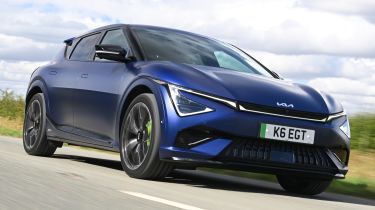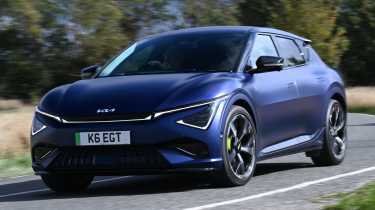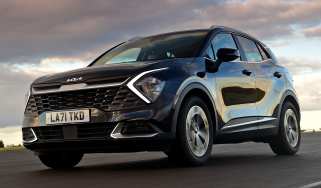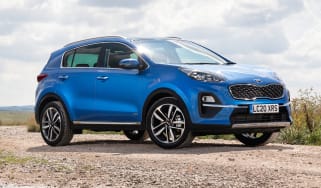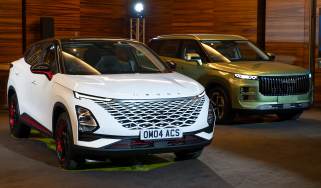Kia EV6 GT review
Flagship of the EV6 range has been given more power, updates to the driving experience and a price cut

Our opinion on the Kia EV6 GT
Enhancements to the Kia EV6 GT driving experience haven’t been entirely successful, but it still delivers an impressive combination of rapid acceleration and long-distance comfort, while the price cut could tempt some buyers away from the rival Hyundai Ioniq 5 N. In reality the two cars deliver different characters, with the Kia missing out on the most focused elements that the Hyundai delivers in favour of a grand touring feel. The Virtual Gear Shift is disappointing in its execution, while the range of drive settings seems overly complicated, but the EV6 GT still has a sporty edge that helps it stand out from the rest of the range.
About the Kia EV6 GT
Many performance electric cars focus on acceleration, but the Kia EV6 GT is a model that attempts to inject some involvement into the mix with a chassis that’s designed to entertain in corners, too. And with the EV6 facelift now coming to the flagship of the range, Kia has given it some enhancements to boost its appeal even further.
The updates include the redesigned front end, with an updated running light signature, while inside there are revised materials that are enhanced by the neon green detailing that is exclusive to the GT model. Under the skin is the bigger battery, while the two-motor powertrain has been boosted by 64bhp and 30Nm to offer maximums of 641bhp and 770Nm respectively.
Used - available now
The electronics have been updated to include what Kia calls a Virtual Gear Shift. Similar in execution to the N e-Shift software, this delivers sequential manual-style shifts that aim to deliver a greater connection between driver and machine, while a sound generator and configurable drive modes allow you to adjust the car as you see fit.
The EV6 GT is pitched against some strong rivals, such as the Polestar 4, while other cars include the BMW i4 and Volkswagen ID.7 GTX.
So far, we’ve driven the pre- and post-facelift EV6 GT extensively, most recently pitting the EV6 GT against the Polestar 4, which the EV6 GT lost to due to not being as efficient or refined.
Kia EV6 GT prices and latest deals
All of these enhancements come at a cost, but it’s one that’s lower than for the outgoing car – a starting price just under £60,000 sounds steep, but that’s nearly £3,000 less than the old model, and around £5,000 less than the Ioniq 5 N.
If you're interested in getting yourself a Kia EV6 GT, we can help. Configure your ideal Kia EV6 now to get top offers from local dealers, check out the latest Kia EV6 leasing deals, or search for used Kia EV6 models with our Buy A Car service. You can even sell your existing car for a great price with Auto Express Sell My Car.
Performance & driving experience
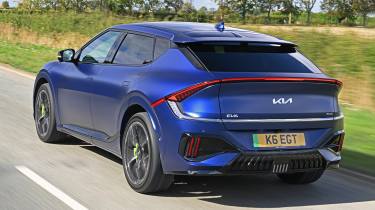
| Pros |
|
| Cons |
|
In many ways, the EV6 is like an electrified successor to the Kia Stinger. The GT version is a car that has a sporting edge, but its size and weight mean it should be considered a grand tourer rather than an out-and-out sports car. There are enough enhancements to help the GT stand out next to the standard model, with bespoke adaptive dampers and additional electronic trickery on board so you can adjust the driving experience however you please.
There’s a firm edge to the EV6 GT’s ride that’s a constant reminder of the car’s potential, but it’s not uncomfortable and offers a reasonable level of refinement to justify the GT badge.
Similar to the Hyundai Ioniq 5 N, and buried within the driver-assistance menu is Kia’s Virtual Gear Shift. The system is designed to emulate the character of a petrol engine and a sequential manual gearbox, with the steering wheel paddles used to shift through six virtual gears. You have to be driving pretty hard to feel the effect of the shifts through the transmission, while the augmented exhaust note isn’t very pleasant. The downshifts offer increasing levels of resistance to boost energy recovery.
Performance, 0-60mph acceleration and top speed
The GT model has two electric motors for four-wheel drive and there’s a total power output of 641bhp and 770Nm of torque. Those figures are similar to the ones offered by the Hyundai Ioniq 5 N, but that shouldn’t be a surprise since both cars are closely related.
Maximum torque is available as soon as you pull away, and when GT mode is selected – via the bright green button on the steering wheel – the EV6 GT manages a gut-churning 0-62mph time of 3.5 seconds.
Launch control is available to optimise the powertrain, and the car dispatches the sprint with the minimum of fuss as the electronics help to get the power to the tarmac. While most rival EVs have a limited top speed, the EV6 GT maxes out at 161mph, although the battery will likely be drained by the time you get there.
| Model | Power | 0-62mph | Top speed |
| EV6 GT | 641bhp | 3.5s | 161mph |
Town driving, visibility and parking
While the EV6 isn’t quite as big as a Polestar 4, it still measures 4.7 metres long and has an 11.9-metre turning circle, so it’s not the most manoeuvrable car when parking. Thankfully, there’s a 360-degree camera system and all-round parking sensors to help, while the EV6 also features remote-parking tech that’s operated via the keyfob, so you can move the car in and out of tighter parking spots while standing next to it.
The steering and throttle are responsive at low speeds, while the firm ride makes its presence felt over potholes and bumpy urban streets. It’s not crashy, but the stiff chassis does have a tendency to follow the road, rather than absorbing any inconsistency.
Country road driving and handling
On faster roads, the firm suspension justifies its presence by limiting roll in corners, although you can still feel the car’s 2.2-tonne-plus kerbweight as the wide tyres hang on for grip.
There are different drive settings for you to choose from, with GT mode firming up the suspension further, sharpening the throttle, steering and brakes, and also slackening off the traction and stability control systems. There’s a Sport mode that keeps the electronic aids on, while Kia offers a personalised setting that allows you to configure each part of the powertrain and suspension as you desire.
However, the car’s sheer weight does make it feel a little disconcerting to explore its limits on the public road.
Motorway driving and long-distance comfort
All that power means you can get up to the national limit in the blink of an eye, and once you’re there, the EV6 GT is a reasonable cruiser. Still, it’s not the last word in refinement because the ride remains on the firm side, and tyre noise is also present.
“It’s inevitable that the EV6 GT will be compared with the Hyundai Ioniq 5 N since they share so much, but the differences between them highlight what can be done to make performance EVs about more than straight-line acceleration. They both have distinct characters, although the Ioniq 5 N has a wider breadth of ability thanks to the more intense driving experience when in its sportiest settings.” - Dean Gibson, senior test editor
Range, charging & running costs

| Pros |
|
| Cons |
|
Electric range, battery life and charge time
A bigger battery helps the EV6 GT to deliver more range than its predecessor. Officially, the increase in capacity raises the quoted figure from 263 miles to 279 miles, although that’s still the shortest range offered by any of the models in the EV6 line-up.
We did a lot of motorway work when we tested the EV6 GT, which goes some way to explaining a relatively poor return of 2.9 miles per kWh, although the Polestar 4 managed to deliver a return of 3.5mi/kWh at the same time. Match our figures and you can expect a range of 244 miles from the EV6, which is around 80 miles less than the Polestar.
It’s possible to top up the Kia’s battery from 10-80 per cent capacity in just 18 minutes from a fast enough source, thanks to a maximum charging speed of 233kW. While that’s impressive, using rapid chargers can be expensive. If you have access to an 11kW three-phase supply, then the battery can be charged from 10 per cent capacity to full in a little less than nine hours, while a more typical 7.4kWh home wallbox charger will take around 13 hours.
If you’re worried about losing range in the winter, Kia has fitted a heat pump as standard to the EV6 GT where it’s only an option on GT-Line S versions of the standard car.
| Model | Battery size | Range | Insurance group |
| EV6 GT | 84kWh | 279 miles | 46 |
Insurance groups
Although the EV6 range sits in higher groups than its mainstream rivals, the GT model in group 46 is a couple of rungs lower than similar rivals, including the Polestar 4 and Hyundai Ioniq 5 N.
Tax
As with all EVs, a three per cent Benefit-in-Kind (BiK) company car tax rating means the EV6 GT will be attractive to business users looking for a sporty family car.
All versions of the EV6 are priced above the £40,000 luxury car levy for road tax, so you won’t save anything there by choosing a less sporty model over the GT version.
Depreciation
The GT has the poorest residuals of the EV6 line-up, retaining 48 per cent of its value after three years. The best performer is the base model, at 51 per cent.
To get an accurate valuation for a Kia EV6 GT, check out our valuation tool...
Interior, design & technology
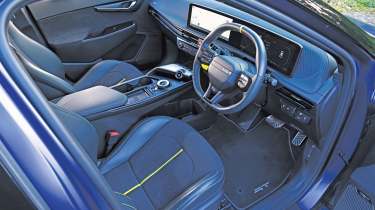
| Pros |
|
| Cons |
|
The exterior revisions are most obvious up front, where there is a new headlight design and full-width LED daytime running light signature, while a bigger battery, up from 77.4kWh to 84kWh, has also been introduced. One other notable update is the Yacht Blue matt paint that’s now offered. It’s a £1,500 option that’s exclusive to the GT model, and helps it to stand out from the rest of the line-up.
Other GT-specific add-ons include the neon green brake calipers, 21-inch alloy wheels and more neon detailing inside.
Interior and dashboard design
Twin screens dominate the dash, while the EV6’s switchgear is shared with most of Kia’s current model line-up.
The larger 12.3-inch screens are positioned side by side for a panoramic look that helps to make the cabin feel wide and boost the sense of space on offer. But to counter this, the high-set centre console offers a clear divide between the front seats for a more cocooned, sporty feel.
A facelift earlier this year introduced a new steering wheel to higher-spec models, while the GT version is marked out from the rest of the range with its suede upholstery and acid green highlights, including the GT button on the lower steering wheel spoke.
Materials and build quality
Build quality feels good, with the rotary drive selector offering a positive action, while the only other physical controls you use frequently are the buttons on the steering wheel, and they have a decent feel.
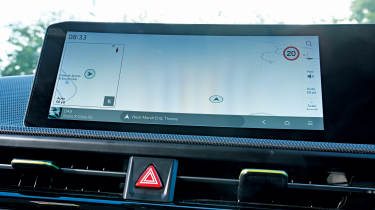
Infotainment, sat-nav and stereo
The main display controls a lot of functions, but Kia’s clever dual-purpose secondary control panel separates the climate and infotainment controls from the main display.
We’d like a bigger button to switch between the two modes, but it’s handy having rotary knobs at either end of the panel to make quick adjustments. One quibble we have with the dashboard layout is the location of the heated seat and steering wheel controls on the leading edge of the centre console. They seem a little lost when everything else is so neatly grouped together.
The GT has the same infotainment set-up that’s found in all of Kia’s EVs, as well as the Sportage and Sorento, although there are some additional functions. Overall, the system is well laid out, but some settings are hidden below the bottom of the screen, so you need to scroll up to use them, which can be frustrating to do on the move. Other sub-menus look a bit fussy, too; the driver-assist function is one of the worst offenders.
Kia offers an excellent seven years of connected services, where some rivals provide only 12 months. Another new feature is fingerprint recognition, which allows drivers to set up their profile by pressing their finger against a sensor located on the dashboard next to the drive selector.
“While there are a number of drive settings to play with, they’re scattered around the dashboard. The drive mode button is on the central steering wheel spoke, while the GT button on the left spoke is for the more extreme modes. If you want to use the VGT shift paddles, then you have to activate the mode via a menu within a menu. If there was one location for all of these features, it would be very useful.” - Dean Gibson, senior test editor
Boot space & practicality
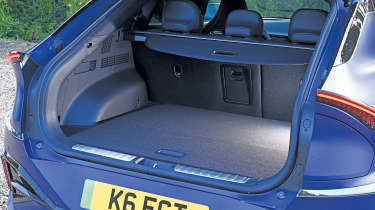
| Pros |
|
| Cons |
|
The EV6 is a quirky design that has unique proportions, with a short bonnet and long curving roof, and it falls somewhere between being an SUV and a family hatchback. The result is a cabin that offers decent space, but is compromised in places. There’s nothing wrong with shoulder and legroom anywhere inside, but headroom might be a little compromised in the back for taller occupants.
Access is fine, with wide-opening doors front and rear, but the sloping roof means you need to be careful when getting in, especially the back. Once there, the five-seat layout is decent.
Dimensions and size
The EV6 has unique proportions, with a long body and low roof, while a wheelbase of 2,900mm means the front and rear overhangs aren’t enormous. It’s a different shape to the average SUV, but not quite a super-sized hatchback like the Hyundai Ioniq 5.
| Dimensions comparison | |||
| Model | Kia EV6 GT | Hyundai Ioniq 5 N | Skoda Enyaq Coupe vRS |
| Length | 4,695mm | 4,715mm | 4,660mm |
| Width | 1,890mm | 1,940mm (2,152mm inc mirrors) | 1,879mm (2,148mm inc mirrors) |
| Height | 1,545mm | 1,625mm | 1,620mm |
| Wheelbase | 2,900mm | 3,000mm | 2,772mm |
| Boot space | 480-1,300 litres (plus 20 litres under the bonnet) | 480-1,540 litres | 570-1,610 litres |
Seats & passenger space
A low roof and crossover styling mean the EV6 isn’t quite as roomy as some rivals that take up a similar amount of space on the road; taller occupants feel as if they’re sitting high with their head near the roof, even with the seat positioned as low as possible.
Thankfully, the sports seats are comfortable and don’t hem you in like some racing buckets, while there’s a wide range of wheel and seat adjustment. Storage space is fine, although the front door bins aren’t very long. The high two-tier centre console includes cup-holders and smartphone charging on top, plus a deep cubby area below.
A long wheelbase means rear kneeroom in the EV6 is among the best of any car we’ve ever tested, but this is offset by a sloping roof that cuts headroom. The backrests recline a little to make more space if you need it.
The flat floor and wide rear bench mean there’s plenty of room for a third passenger, but while large door openings make it easy to insert a child seat, the two sets of Isofix mounts are a little awkward to reach.
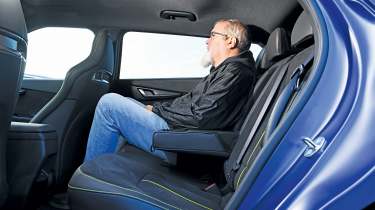
Boot space
There’s a huge floor area to work with, but it’s shallow, and when combined with the steeply raked tailgate and the Meridian subwoofer in the corner, means there’s just 480 litres of space. If you need a more practical boot, then the vast Skoda Enyaq Coupe vRS with 570 litres of space is going to be a better option.
Kia doesn’t quote a volume with the EV6’s back seats folded, but dropping them is straightforward, and there’s a small step in the floor. The back seats fold in a 60:40 split and features a ski hatch to help with loading longer items. There’s also space under the bonnet for storage, with a 20-litre tray that sits above some of the car’s electric running gear. It’s awkwardly shaped, though, so you can just about fit a charging cable in, but not a lot else.
“You can charge electrical devices via the four USB-C sockets dotted around the cabin – two up front, another two for the back seats – but the EV6 also has traditional 12-volt sockets up front and in the boot, plus a three-pin socket in the rear cabin for charging larger items.” – Dean Gibson, senior test editor
Towing
A towing weight of 1,800kg is quoted for the EV6 GT, which means it matches the rest of the range. This is one of the better quoted figures offered by an electric family car.
Reliability & safety

| Pros |
|
| Cons |
|
The Kia brand has dropped to 18th out of 31 manufacturers in the Driver Power customer satisfaction survey this year, down from third in 2024.
Euro NCAP gave the standard EV6 a five-star safety rating in 2022, while the most recent update introduced reinforced B-pillars that should further boost its credentials.
| Euro NCAP safety ratings | |
| Euro NCAP safety rating | Five stars (2022) |
| Adult occupant protection | 90% |
| Child occupant protection | 86% |
| Vulnerable road user protection | 64% |
| Safety assist | 87% |
Buying and owning
There’s just the one variant offered, so take it or leave it. It has twice the power of the next model in the EV6 line-up, so could be worth the £2,000 jump in price on that basis alone. However, you also get a sharper look, adaptive dampers and a heat pump, so there’s much more to its appeal than just a 3.5 second 0-62mph time.
Aside from paint colours, including the distinctive £1,500 Yacht Blue matt of our test car, there are just accessories to add. A vehicle-to-load adapter that lets you charge devices from the drive battery costs £295.
Kia EV6 GT alternatives
The most obvious alternative to the EV6 GT is the Hyundai Ioniq 5 N. It uses the same platform but has slightly different electronic assistance, and it edges ahead for driver involvement. It costs around £5,000 more than the EV6 GT, though, and that might be a bit of a step up for some buyers. Elsewhere, competition comes from performance versions of electric SUVs, such as the Volkswagen ID.4 GTX/ID.5 GTX, Ford Mustang Mach-E GT, Skoda Enyaq vRS and Nissan Ariya Nismo. Some of these aren’t much more than badge upgrades, though, and the EV6 GT offers a bit more of a driver-focused package.
Deals on the Kia EV6 and alternatives
Kia EV6 GT pictures
Frequently Asked Questions
Kia’s seven-year/100,000-mile cover is valid on all of its cars. The battery is covered by a separate eight-year/100,000-mile warranty, which guarantees that the level of charge will stay above 70 per cent of its original capacity during that period.

